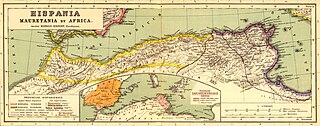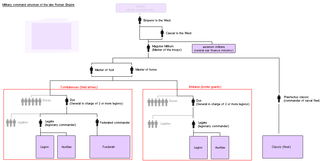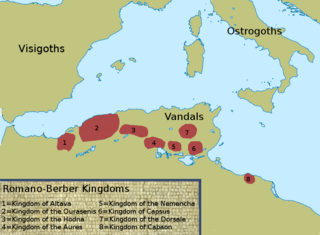Related Research Articles
The 470s decade ran from January 1, 470, to December 31, 479.
The 390s decade ran from January 1, 390 to December 31, 399

Mauretania is the Latin name for a region in the ancient Maghreb. It extended from central present-day Algeria to the Atlantic, encompassing northern present-day Morocco, and from the Mediterranean in the north to the Atlas Mountains. Its native inhabitants, of Berber ancestry, were known to the Romans as the Mauri and the Masaesyli.

Procopius Anthemius was the Western Roman emperor from 467 to 472. Born in the Eastern Roman Empire, Anthemius quickly worked his way up the ranks. He married into the Theodosian dynasty through Marcia Euphemia, daughter of Eastern emperor Marcian. He soon received a significant number of promotions to various posts, and was presumed to be Marcian's planned successor. However, Marcian's sudden death in 457, together with that of Western emperor Avitus, left the imperial succession in the hands of Aspar, who instead appointed Leo, a low-ranking officer, to the Eastern throne, probably out of fear that Anthemius would be too independent. Eventually, this same Leo designated Anthemius as Western emperor in 467, following a two-year interregnum that started in November 465.

Magister militum was a top-level military command used in the late Roman Empire, dating from the reign of Constantine the Great. The term referred to the senior military officer of the empire. In Greek sources, the term is translated either as strategos or as stratelates.

The Exarchate of Africa was a division of the Byzantine Empire around Carthage that encompassed its possessions on the Western Mediterranean. Ruled by an exarch (viceroy), it was established by the Emperor Maurice in 591 and survived until the Muslim conquest of the Maghreb in the late 7th century. It was, along with the Exarchate of Ravenna, one of two exarchates established following the western reconquests under Emperor Justinian I to administer the territories more effectively.

Mauretania Sitifensis was a Roman province in Northwest Africa. The capital was Setifis.

The Praetorian Prefecture of Africa was an administrative division of the Byzantine Empire in the Maghreb. With its seat at Carthage, it was established after the reconquest of northwestern Africa from the Vandals in 533–534 by the Byzantine Emperor Justinian I. It continued to exist until 591, when it was replaced by the Exarchate of Africa.

Mauri was the Latin designation for the Berber population of Mauretania, located in the west side of North Africa on the shores of the Mediterranean Sea, Mauretania Tingitana and Mauretania Caesariensis, in present-day Morocco and northwestern Algeria.
Gennadius was an East Roman (Byzantine) general and the first exarch of Africa.

Altava was an ancient Romano-Berber city in present-day Algeria. It served as the capital of the ancient Berber Kingdom of Altava. During the French presence, the town was called Lamoriciere. It was situated in the modern Ouled Mimoun near Tlemcen.
Solomon was an East Roman (Byzantine) general from northern Mesopotamia, who distinguished himself as a commander in the Vandalic War and the reconquest of North Africa in 533–534. He spent most of the next decade in Africa as its governor general, combining the military post of magister militum with the civil position of praetorian prefect. Solomon successfully confronted the large-scale rebellion of the native Berbers, but was forced to flee following an army mutiny in spring of 536. His second tenure in Africa began in 539 and it was marked by victories over the Berbers, which led to the consolidation of the Byzantine position. A few years of prosperity followed, but were cut short by the rekindled Berber revolt and Solomon's defeat and death at the Battle of Cillium in 544.
Cutzinas or Koutzinas was a Berber tribal leader who played a major role in the wars of the East Roman or Byzantine Empire against the Berber tribes in Africa in the middle of the 6th century, fighting both against and for the Byzantines. A staunch Byzantine ally during the latter stages of the Berber rebellion, he remained an imperial vassal until his murder in 563 by the new Byzantine governor.

Byzantine rule in North Africa spanned around 175 years. It began in the years 533/534 with the reconquest of territory formerly belonging to the Western Roman Empire by the Eastern Roman (Byzantine) Empire under Justinian I and ended during the reign of Justinian II with the conquest of Carthage (698) and the last Byzantine outposts, especially Septem (708/711), in the course of Islamic expansion.

The Kingdom of Altava was an independent Christian Berber kingdom centered on the city of Altava in present-day northern Algeria. The Kingdom of Altava was a successor state of the previous Mauro-Roman Kingdom which had controlled much of the ancient Roman province of Mauretania Caesariensis. During the reign of Kusaila, it extended from Volubilis in the west to the Aurès and later Kairaouan and the interior of Ifriqiya in the east. This Kingdom collapsed following Eastern Roman military campaigns to decrease its influence and power after Garmul invaded the Exarchate of Africa.

The Mauro-Roman Kingdom, also described as the Kingdom of Masuna, was a Christian Berber kingdom which dominated much of the ancient Roman province of Mauretania Caesariensis from the capital city of Altava. Scholars are in disagreement about whether the polity aimed for independence as a kingdom or was part of a loose confederation, an alternative hypothesis drawn from contextual knowledge about Berber tribal alliances. In the fifth century, Roman control over the province weakened and Imperial resources had to be concentrated elsewhere, notably in defending Roman Italy itself from invading Germanic tribes. Moors and Romans in Mauretania came to operate independently from the Empire. However, regional leaders may not have necessarily felt abandoned by the Romans.

The Kingdom of the Aurès was an independent Christian Berber kingdom primarily located in the Aurès Mountains of present-day north-eastern Algeria. Established in the 480s by King Masties following a series of Berber revolts against the Vandalic Kingdom, which had conquered the Roman province of Africa in 435 AD, Aurès would last as an independent realm until the Muslim conquest of the Maghreb in 703 AD when its last monarch, Queen Dihya, was slain in battle.
The Byzantine–Moorish wars were a series of wars fought between the Byzantine Empire and the various Berber kingdoms which formed after the collapse of Roman North Africa. The war also featured other rebels such as the renegades of Stotzas and the Vandalic rebels of Guntarith. The war ended with the Berbers attempting to push the Romans out of Africa being defeated at the battle of the Fields of Cato, and the Byzantines being too weakened to take over the various newly formed kingdoms such as Altava and the Kingdom of the Aurès.
Sergius was a Byzantine military officer who was active in Byzantine Africa during the reign of the emperor Justinian I. The son of a priest named Bacchus, he was the brother of two Byzantine officers and nephew of the famous general Solomon. When appointed governor of Tripolitania, he murdered 80 of the leaders of the Laguatan, which intensified hostilities with the Moorish tribes.
References
- ↑ Unesco, GHA (2010). Trade in the western Mediterranean, AD 400-700, 439-700. California: University of California Press, 1981. p. 508. ISBN 978-0435948054.
- ↑ PLRE IIIa, p. 504
- ↑ El Africa Bizantina, pp. 45-46
- ↑ Leclercq, Henri (1904). L'Afrique chrétienne (in French). V. Lecoffre.